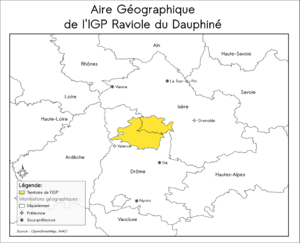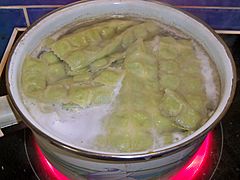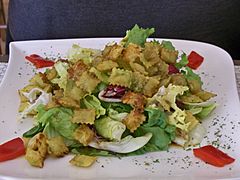Raviole du Dauphiné facts for kids
Ravioles du Dauphiné are a special kind of pasta from France. They are like small, square ravioli or pelmeni. They have two thin layers of pasta made from wheat flour, eggs, and water. Inside, there's a yummy filling of cheese, butter, and parsley. The cheese is usually Comté or French Emmental. These tasty bites come from the Dauphiné region in South-Central France. You can find them especially around the town of Romans-sur-Isère. The name Ravioles du Dauphiné has been officially protected since 1989. They even got a special quality award called Label Rouge in 1998.
Contents
A Look at Ravioles History
Ravioles have a very long history, going back to ancient Roman times. The first time they were written about was in 1228. During the Middle Ages, people in the Dauphiné region ate a lot of ravioles. Back then, they were filled with meat or root vegetables. People who didn't have much money, or those observing special fasting times like Lent, often ate ravioles without meat.
The first time ravioles from the town of Romans were mentioned was in 1807. Around this time, people in the area became more successful. This meant they started using cheese in their ravioles instead of just vegetables. By the 1960s, ravioles began to be made in large factories. By 1975, about 100 tonnes of ravioles were made each year! Since the 1990s, you can easily find ravioles in supermarkets.
Where Ravioles Come From
Ravioles du Dauphiné are made in Romans-sur-Isère. They also come from the wider Royans region. This area covers parts of two French departments: Drôme and Isère, both in Auvergne-Rhône-Alpes. To make sure they are truly authentic, any eggs or cream cheese used for ravioles must also come from this specific region.
How Ravioles Are Made and Sold
The production of Ravioles has grown a lot! In 2005, about 2500 tonnes were made. Just two years later, in 2007, that number more than doubled to 5103 tonnes.
Ravioles are usually sold in flat packs. Each pack has 48 small pieces and weighs about 60-65 grams. You can enjoy them in many restaurants in the region. There are even special events to celebrate them! The Festival of Ravioles and Pognes (another local treat like a doughnut) happens every September in Romans. There's also a traditional Raviole Festival in Eymeux.
How to Enjoy Ravioles
Ravioles are very versatile and can be cooked in different ways. You can gently cook them in hot water. Or, you can grill them in a frying pan until they are slightly crispy.
Once cooked, they can be served in many delicious ways:
- In a warm meat broth.
- Baked in a gratin, which is a dish cooked with cheese on top.
- Served simply with a fresh salad.
See also
 In Spanish: Raviole du dauphiné para niños
In Spanish: Raviole du dauphiné para niños







